Modern crypto wallets consist of three fundamental layers: key management for handling cryptographic keys, accounts for user identification and interaction, and interface for user engagement. Each layer has its own challenges and innovations that shape the overall wallet experience.
Key management has evolved beyond simple private keys to more sophisticated solutions: Shamir's Secret Sharing splits keys into fragments, Threshold Signature Schemes enable multi-party computation without key reconstruction, and Trusted Execution Environment uses hardware-level isolation. Projects like Privy, Particle Network, and Turnkey demonstrate these different approaches in practice.
Account abstraction is making blockchain interactions more user-friendly by turning complex accounts into programmable interfaces. This enables features like gasless transactions, social recovery, and customizable security settings, making blockchain technology more accessible to mainstream users, as demonstrated by projects like Abstract's Global Wallet.
Chain abstraction is solving the complexity of cross-chain interactions by making different blockchains invisible to end users. Users can manage balances across chains, pay with any token, and interact with multiple blockchains seamlessly while maintaining decentralization and security. One Balance's Credible Accounts system shows one approach to implementing these features.
The crypto industry is rapidly shifting from desktop to mobile-first development, with platforms like Zora leading the transformation by delivering sophisticated mobile experiences while keeping blockchain complexity under the hood.
The future of wallet development hinges on simplifying user experience without compromising security. The path to broader adoption requires evolving beyond private keys to social logins while matching the seamless experience of Web2 apps - all while preserving blockchain's core benefits.
For crypto applications facing end-users, wallets are far more than just digital containers for assets – they're the gateway to the entire blockchain experience. Every interaction with a crypto application, from initial setup to daily transactions, flows through the user's wallet. This makes wallets not just a feature, but the fundamental infrastructure that shapes how users engage with blockchain technology.
Creating and funding a new wallet represents a significant investment of time, effort, and risk tolerance from users. While this high barrier to entry drives up customer acquisition costs for applications, it also creates a powerful retention mechanism – once users are set up with a wallet, they're likely to stick around rather than go through the process again elsewhere.
Yet despite their pivotal role, crypto wallets have earned a reputation for having some of the most challenging user experiences in technology. First-time users often find themselves navigating a maze of technical concepts – private keys, public keys, seed phrases – with little room for error. This complexity has led many to question whether such a steep learning curve is truly necessary to fully harness blockchain technology.
However, the landscape is finally coming to change. After years of stagnation, wallet technology is experiencing a renaissance driven by a growing focus on user experience. Modern wallets are bridging the gap between Web2 convenience and Web3 security through innovations like social login authentication, biometric verification, and gas fee abstraction. These developments are finally bringing crypto wallets closer to the user-friendly experience people expect from modern applications.
The technical infrastructure of blockchain wallets consists of three fundamental layers:
Key Management: This foundational layer orchestrates the generation, storage, and recovery of cryptographic keys. It encompasses critical technical decisions about encryption methods, security protocols, and access controls. Modern solutions have evolved beyond basic key storage to include advanced approaches like Multi-Party Computation (MPC), Shamir's Secret Sharing (SSS), social login integration, and mobile-friendly Passkeys.
Accounts: This layer defines how users are identified and interact with blockchain networks. It spans from basic Externally Owned Accounts (EOAs) to sophisticated Smart Contract Accounts (SCAs). Each account type can be enhanced with different capabilities – from gas fee sponsorship and multi-signature requirements to customizable transaction controls – which ultimately determine the wallet's functionality and versatility.
Interface: This is where users directly engage with the blockchain. Whether through browser extensions, mobile apps, or web interfaces, this layer provides the essential points for user actions like signing transactions, managing assets, and connecting to dApps.
Each of these layers comes with its own set of design considerations and trade-offs. How they're implemented and integrated shapes the overall wallet experience. Throughout this article, we'll examine each layer's components and recent innovations, exploring how different approaches contribute to creating more user-friendly crypto applications.
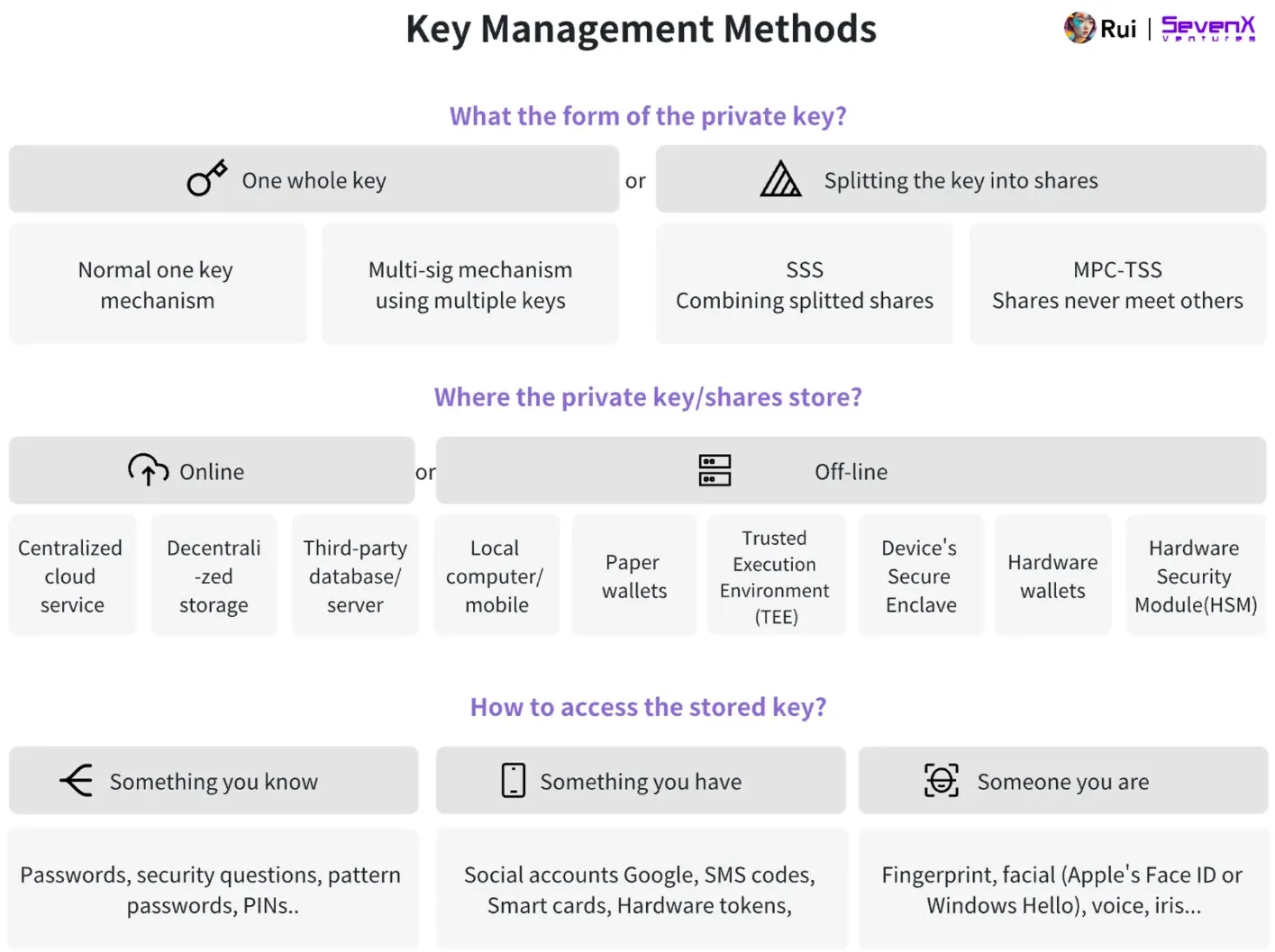
Source: WebAuthn and Passkey, Key Management for Daily Crypto Users
The key management layer encompasses three critical decision points:
Key Generation: At its core, key generation method defines how to create and use keys to sign transactions. While single private keys remain the traditional approach, the industry is increasingly adopting sophisticated solutions like Multi-Party Computation (MPC) and Shamir's Secret Sharing (SSS). These newer methods distribute the key generation and signing processes across multiple parties, striking a better balance between security and usability.
Storage: This component determines where generated keys or their fragments are stored. The selection depends on various factors: security requirements, accessibility needs, operational costs, and degree of decentralization desired. Available options span from centralized cloud servers like AWS to decentralized storage solutions, personal storage devices, and hardware wallets, each presenting distinct advantages and trade-offs.
Authentication: Users prove their identity and access their keys using various authentication method. Traditional password-based systems are giving way to more user-friendly methods like social login and Passkeys, reflecting the industry's shift toward better user experience, particularly on mobile devices.
When implementing a key management system, each of these components can be configured differently based on specific needs – whether that's the application's purpose, technical constraints, or business requirements. Among current market solutions, the key differentiator often lies in the chosen combination of key generation and authentication methods, as these choices fundamentally shape the balance between security and user experience.

Source: Wallets and architectures, part 2: Walking the decision tree
The earliest approach to key management was straightforward but demanding: users maintained complete control over their private keys through Externally Owned Accounts (EOAs). While this direct ownership model continues to be widely used, its limitations have become increasingly apparent. New users often struggle with the technical complexity of key management, while even experienced users face significant security risks – from potential hacking to the permanent loss of funds if keys are misplaced.
In response to these challenges, the industry has developed three distinct approaches to modern key management: Shamir's Secret Sharing (SSS) which distributes key fragments across multiple locations, Multi-Party Computation (MPC) which enables collaborative transaction signing, and Trusted Execution Environment (TEE) which provides a secure enclave for key operations. Each of these solutions addresses traditional wallet limitations in unique ways, offering different balances of security, usability, and decentralization, which we'll explore in depth throughout the following sections.
Developed in the 1970s, SSS is a cryptographic algorithm that enhances security by splitting a secret key into multiple fragments. This approach serves two primary purposes: it eliminates the single point of failure inherent in individual key custody while ensuring the key remains recoverable when needed. The system's defining characteristic is its threshold mechanism – a specific minimum number of fragments must be combined to reconstruct the original key, with any smaller collection of fragments revealing absolutely nothing about the key's content.
In practice, SSS operates by generating a private key locally on the user's device, splitting it into multiple fragments, and distributing these fragments across different stakeholders – typically including both the user and service providers. For transaction signing, the system temporarily reunites the required number of fragments to reconstruct the key. This method delivers enhanced security features while seamlessly integrating with existing blockchain infrastructure.
Advantages:
Proven Stability: The algorithm's decades-long history has provided extensive validation, resulting in multiple battle-tested open-source implementations.
Flexible Key Distribution: Administrators can precisely customize both the total fragment count and the threshold number needed for reconstruction.
Modularity: Storage solutions for individual fragments can be updated independently, enabling targeted system improvements without full-scale changes.
Scalability: The client-side computation model ensures consistent performance regardless of user base size.
Disadvantages:
Key Reconstruction Vulnerability: The moment of key reconstruction during transaction signing creates a temporary security vulnerability.
Verification Limitations: SSS lacks cryptographic methods to verify successful fragment deletion or initial key generation accuracy.
Complex Implementation: The solution often demands sophisticated development expertise, particularly in securing client-side operations.
Case Study: Privy
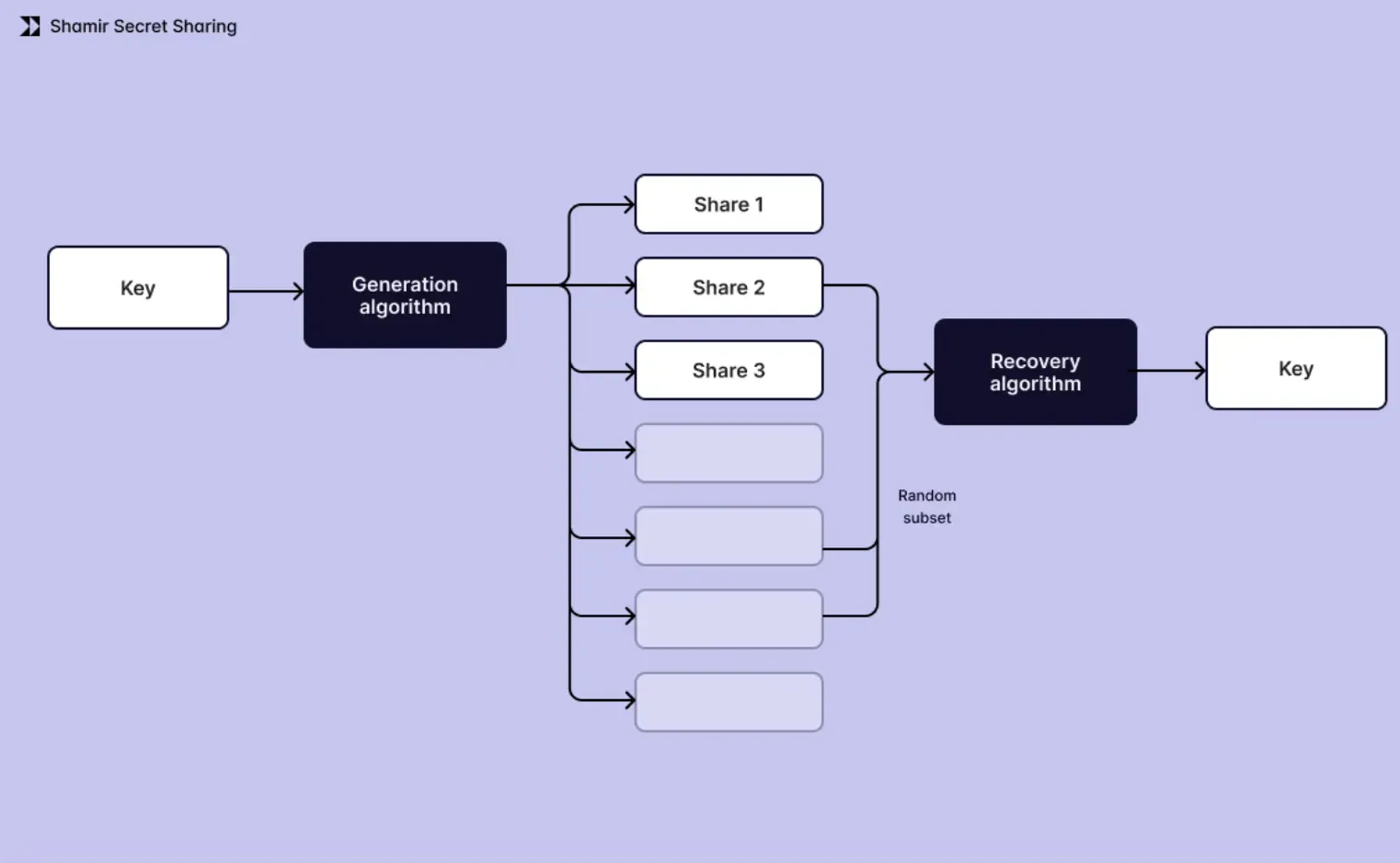
Source: Sharing the secret
Privy exemplifies advanced SSS implementation in modern wallet architecture. Their embedded wallet solution leverages a secure, isolated iframe environment where it generates wallet credentials using a CSPRNG. Then the system derives both the wallet's public address and private key through mnemonic generation.
After the initial generation, the system employs SSS to divide the private key into three distinct fragments:
Device Share: Resides locally on the user's device, stored in the browser's local storage when using web applications.
Auth Share: Maintained on Privy's servers in encrypted form, accessed during the authentication process.
Recovery Share: Flexibly stored either within Privy's key management infrastructure or directly by the user.
A crucial security feature is that the complete private key exists only momentarily in memory during operations, never persisting in any permanent storage. The system's architecture requires any two fragments to reconstruct the key, creating three powerful recovery pathways:
Device Share + Auth Share: Represents the standard user flow. Users authenticate through social login or similar methods, triggering the decryption of their Auth Share, which combines with their local Device Share.
Device Share + Recovery Share: Provides a fallback mechanism when Privy's servers are inaccessible or users lose access to their primary authentication method.
Auth Share + Recovery Share: Facilitates seamless device migration by enabling the generation of a new Device Share on additional devices.
Privy's sophisticated recovery system enables secure wallet access across diverse scenarios without compromising security. This implementation successfully navigates the delicate balance between robust security measures and user accessibility in digital asset management.
TSS is a form of Multi-Party Computation (MPC) where multiple participants collectively generate and combine signature shares to perform cryptographic operations on a shared secret. Unlike SSS, a key characteristic of TSS is that participants can combine their signature shares to perform operations without needing to reconstruct the key.
TSS can be implemented in various ways, from large-scale networks involving multiple computing nodes to simple two-party signature schemes between a user and a service provider. Participants can contribute to signature generation without directly knowing the secret key, enabling a flexible signing process while maintaining enhanced security.
Advantages:
Enhanced Security: Eliminates the single point of failure present in SSS by removing the need for key reconstruction
Flexible Architecture: Allows customizable configuration of the number of participants and required signatures, enabling various trust models
Disadvantages:
Technical Maturity: As a relatively recently commercialized technology, there are fewer proven implementations and large-scale deployment cases
Scalability Limitations: TSS-based systems require communication between participants, resulting in slower processing speeds, particularly when implementing ECDSA on Ethereum
Implementation Complexity: Requires coordination and communication between multiple parties, leading to complex implementation and higher operational costs
In summary, while TSS has gained attention as a powerful alternative that addresses the single point of failure issue in SSS, its current implementation faces some limitations in terms of performance and complexity. These constraints somewhat restrict its scalability in practical applications.
Case Study: Particle Network
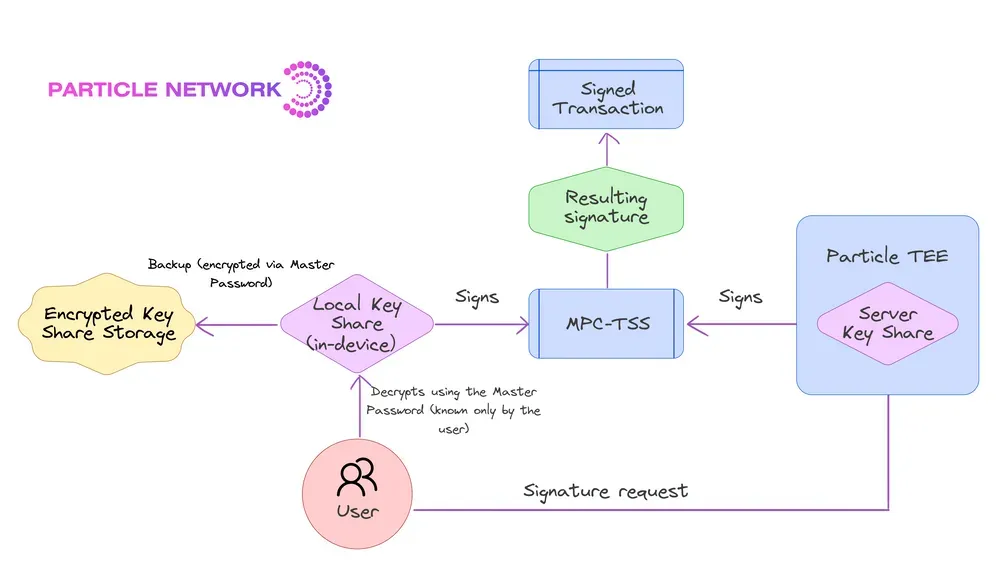
Source: Particle Network Docs
Particle Network serves as a prime example of implementing MPC-TSS to provide a user-friendly wallet solution. They've specifically adopted a 2/2 TSS approach, ensuring that private keys are never concentrated in a single location throughout their entire lifecycle - from generation to storage and usage.
In Particle Network's TSS implementation, two independent key shares are generated and stored in separate locations. One share is stored in the user's local environment, while the other is kept in Particle's Trusted Execution Environment (TEE). Importantly, each share alone reveals no information about the complete key, and operations are performed by combining the shares without ever reconstructing the full key.
As an additional security layer, users can set a master password that encrypts their locally stored key share. This provides an extra level of security beyond social login authentication while still allowing secure wallet recovery across different devices.
Currently, Particle Network supports MPC-based signing for both Solana and EVM-based chains. Through this approach, Particle Network offers a secure, non-custodial key management system that remains user-friendly and chain-agnostic.
TEE takes a completely different approach from SSS or MPC. It performs all private key-related operations within a secure isolated execution environment (enclave). This security is guaranteed at both hardware and software levels through platforms like Intel SGX or AWS Nitro Enclaves.
In TEE-based systems, authorized code runs in a remote enclave with isolated CPU and memory resources, protected from external monitoring or interference. The enclave can generate certificates proving that operations were performed correctly, allowing users to verify that their private keys are being handled securely. This provides a simple yet powerful platform for key management. Unlike SSS or TSS, which require complex key splitting or multi-party computation, TEE enables secure key management through hardware-level guarantees.
Advantages:
Strong Security: Provides high-level security through hardware-level isolation
Verifiability: Can cryptographically prove that all operations were performed as intended
Efficient Performance: Requires less network communication compared to TSS, enabling relatively faster processing
Disadvantages:
Hardware Dependency: High dependence on specific hardware or vendors, which could lead to centralization or censorship risks
Security Vulnerabilities: If the enclave itself is compromised, the entire system could be at risk
TEE offers a practical solution to key management problems through hardware-based security. While it enables simpler implementation than SSS and more efficient operation than TSS, the dependence on hardware platforms remains a consideration that needs careful attention.
Case Study: Turnkey
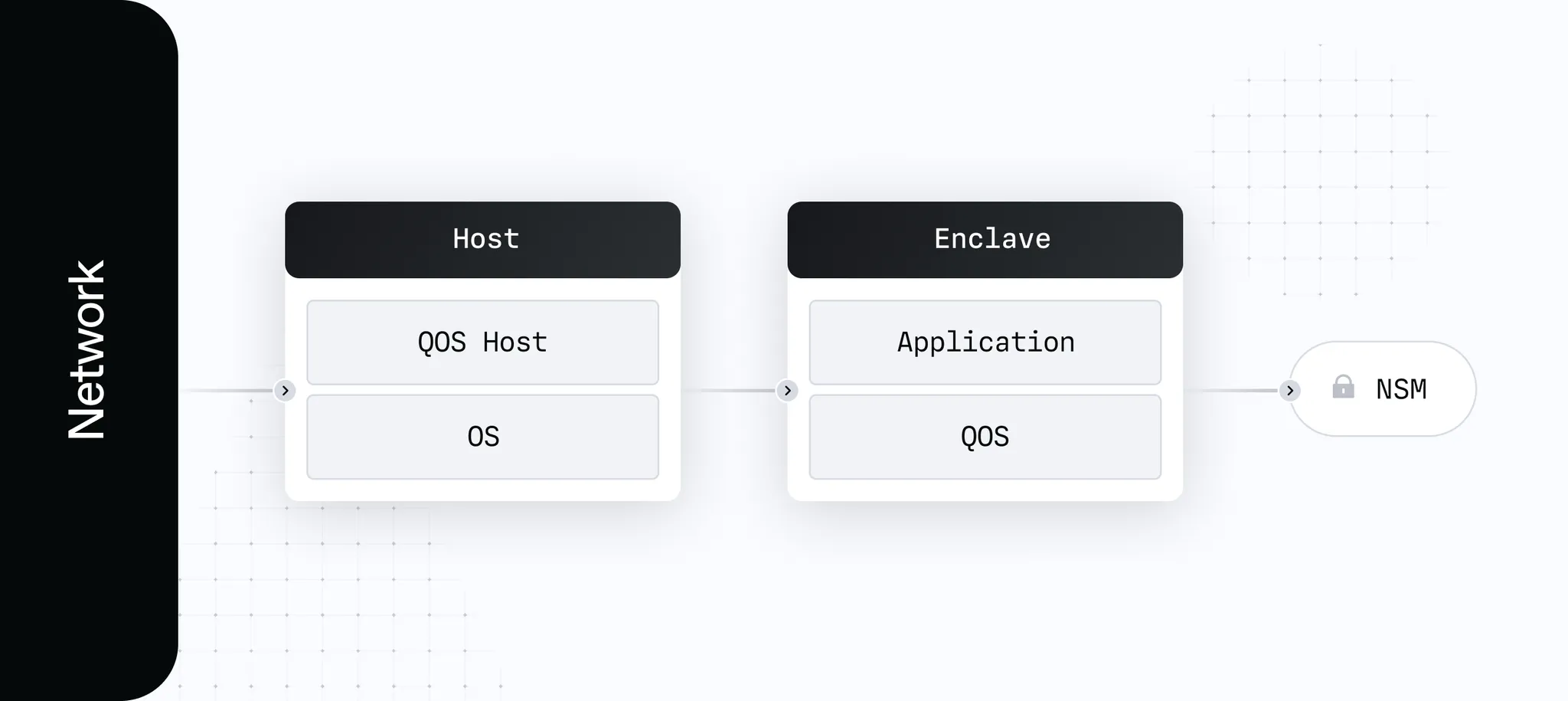
Source: Turnkey Docs
Turnkey's core security policy revolves around processing all security-critical operations within TEEs. In their system, all security-sensitive services - including key generation, signing, and policy engines - are executed within secure enclaves.
Turnkey's architecture consists of two main components:
Host: This is a standard AWS virtual machine that runs basic applications for receiving network traffic and making enclave calls. It acts as a buffer zone between the enclave and external systems, serving as a layer for collecting metrics and other operational information about enclave operations.
Enclave: This is a completely isolated environment from external connections, with only a virtual serial connection to the host and its own security coprocessor, known as the Nitro Security Module (NSM) in AWS. This environment runs QuorumOS (QOS), Turnkey's enclave operating system, along with security applications that operate on top of it.
Through this structure, Turnkey can prove to both itself and its users that all security-critical systems operate exactly as intended. The enclave operates in a highly restricted computing environment with no permanent storage, interactive access, or external networking, thereby providing the highest level of security.
As blockchain technology continues to evolve and reach mainstream adoption, there's an increasing need to abstract away its technical complexities. Wallets represent the primary touchpoint between users and blockchain networks, yet they often present significant barriers to entry. New users must grapple with unfamiliar concepts like private key management, gas fee payments, and transaction signing – technical aspects that can be daunting and unnecessarily complex for the average user.
This need for abstraction mirrors the evolution of other technologies we use daily. Consider how we interact with the internet: users don't need to understand TCP/IP protocols or DNS systems to browse websites. Similarly, making a phone call doesn't require knowledge of GSM or LTE technologies. This pattern is consistent across mature technologies – as they evolve, their technical complexities become increasingly hidden behind user-friendly interfaces.
In this chapter, we explore two fundamental abstraction concepts that are reshaping wallet user experience. The first is Account Abstraction, which transforms complex blockchain accounts into programmable, user-friendly interfaces. The second is Chain Abstraction, which eliminates the complexity of cross-chain interactions, allowing users to seamlessly operate across different blockchain networks without understanding the underlying mechanics.
EOAs in their original form served only basic functions: storing addresses and signing transactions. The lack of programmability at the account level meant that any advanced features or customization were impossible. The introduction of account abstraction changed this landscape by enabling functional enhancements directly at the account level. While account abstraction initially showed promise in addressing blockchain's user experience challenges, several barriers delayed its widespread adoption. Complex implementation requirements, high gas costs, and poor compatibility with existing EOAs all contributed to the slower adoption than our expectation. The technology has since matured beyond its early challenges and is now moving toward practical implementation. A few recently launched consumer applications have successfully integrated account abstraction to the point where end users can interact with blockchain applications seamlessly, often without realizing they're using a wallet or blockchain. This development signals potential for broader adoption beyond the existing crypto user base. The impact of account abstraction continues to expand throughout the crypto ecosystem. Layer 2 rollups are now incorporating it at the protocol level to enhance user experience, while Wallet-as-a-Service (WaaS) providers deploy more advanced embedded wallet solutions. The technology's significance is further highlighted by the upcoming Ethereum Pectra upgrade, which includes EIP-7702 – allowing EOAs to leverage temporal programability of SCAs on the mainnet.
Case Study: Abstract
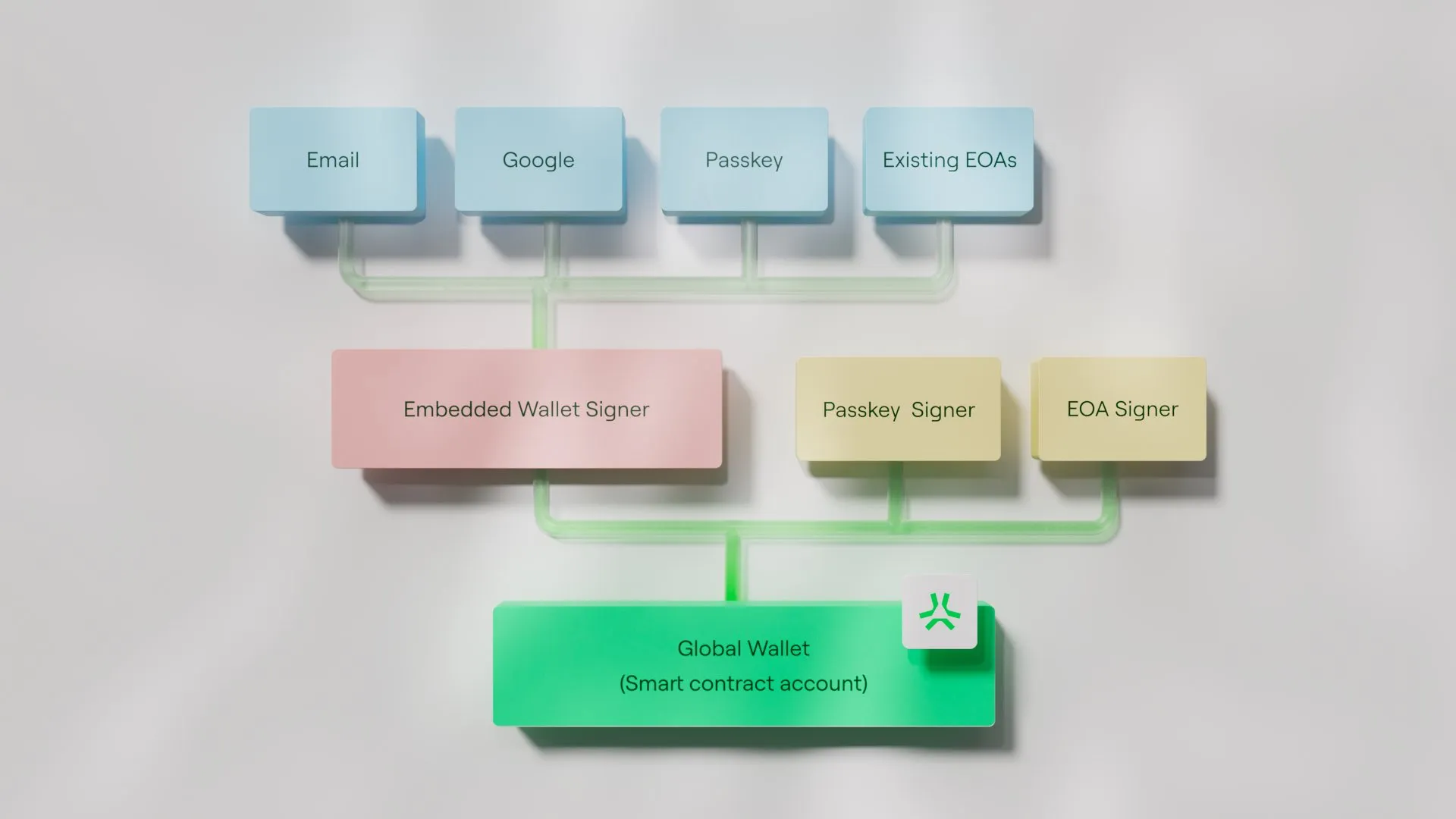
Source: Abstract Global Wallet
Abstract has developed the Abstract Global Wallet (AGW), a universal embedded wallet designed to work across their platform's applications. Unlike application-specific wallets, AGW serves as a comprehensive solution that allows users to access any application within the Abstract ecosystem. The wallet addresses a practical need: allowing users to manage their data and assets across multiple applications through a single access point.
AGW implements Native Account Abstraction to create smart contract wallets with enhanced security and flexibility compared to traditional EOAs. This approach treats all accounts as smart contracts, ensuring they follow the same transaction lifecycle. While traditional Ethereum maintained separate processes for EOAs and smart contract accounts, Abstract's implementation handles all accounts uniformly, providing consistent functionality for both existing EOA users and those using new AA wallets.
The wallet creation process follows a straightforward two-step approach to integrate EOAs and Smart Contract Accounts (SCAs). When users log in through familiar methods like email, social login, or passkeys, the system creates an EOA wallet in the background. This EOA address then becomes an authorized signer for a deployed smart contract wallet. This design removes the complexity of blockchain wallet creation while maintaining its security features.
Abstract's native account abstraction follows zkSync's standards, with these key components:
IAccount Standard Interface: Defines required methods for all smart contract accounts, standardizing account behavior and ensuring consistency
DefaultAccount Conversion: EOA wallets (e.g. MetaMask) are automatically converted to DefaultAccount implementations of IAccount during transaction processing, enabling them to access SCA's advanced features
Paymaster Support: All accounts can sponsor gas fees for other accounts or pay gas fees using ERC-20 tokens instead of ETH, significantly lowering barriers to entry for new users
Through this architecture, Abstract allows users to seamlessly access advanced features without understanding the underlying complexity. Users simply log in through familiar methods like email or social accounts, and the system automatically handles EOA creation and smart contract wallet deployment in the background. Once initialized, users can access features like multi-signature setup, transaction limits, and account recovery mechanisms.

Source: Cross-app ecosystem
Alongside native account abstraction, AGW incorporates Privy's Cross App Wallet to support its consumer-focused approach. Traditional embedded wallets, while offering simple social login and key management, have been limited by their application-specific nature, resulting in fragmented asset management across platforms. The Cross-app Wallet concept, implemented in AGW, solves this by enabling users to access their assets and data across multiple applications with a single authentication.
The development of a universal embedded wallet presents significant technical challenges, particularly in security architecture. Unlike application-specific wallets where security risks are contained, a cross-application wallet means that security issues in one application could potentially impact all connected applications. This requires a more robust security model. However, the benefits of this approach are substantial:
Simplified Asset Management: Single deposit point for use across all integrated applications
Consolidated Overview: Centralized tracking of assets across multiple applications for both users and developers
Seamless Transfers: Direct asset movement between different applications within the ecosystem
Moving beyond account abstraction, chain abstraction has emerged as a significant concept in recent blockchain development. While account abstraction focused on improving user experience within individual blockchains, chain abstraction addresses a different challenge: enabling users to seamlessly interact with assets across multiple chains without dealing with bridging mechanics. At its core, chain abstraction aims to make the concept of different blockchains transparent to the end user, a need that has become increasingly important as the proliferation of modular blockchains continues to create a more complex onchain ecosystem.
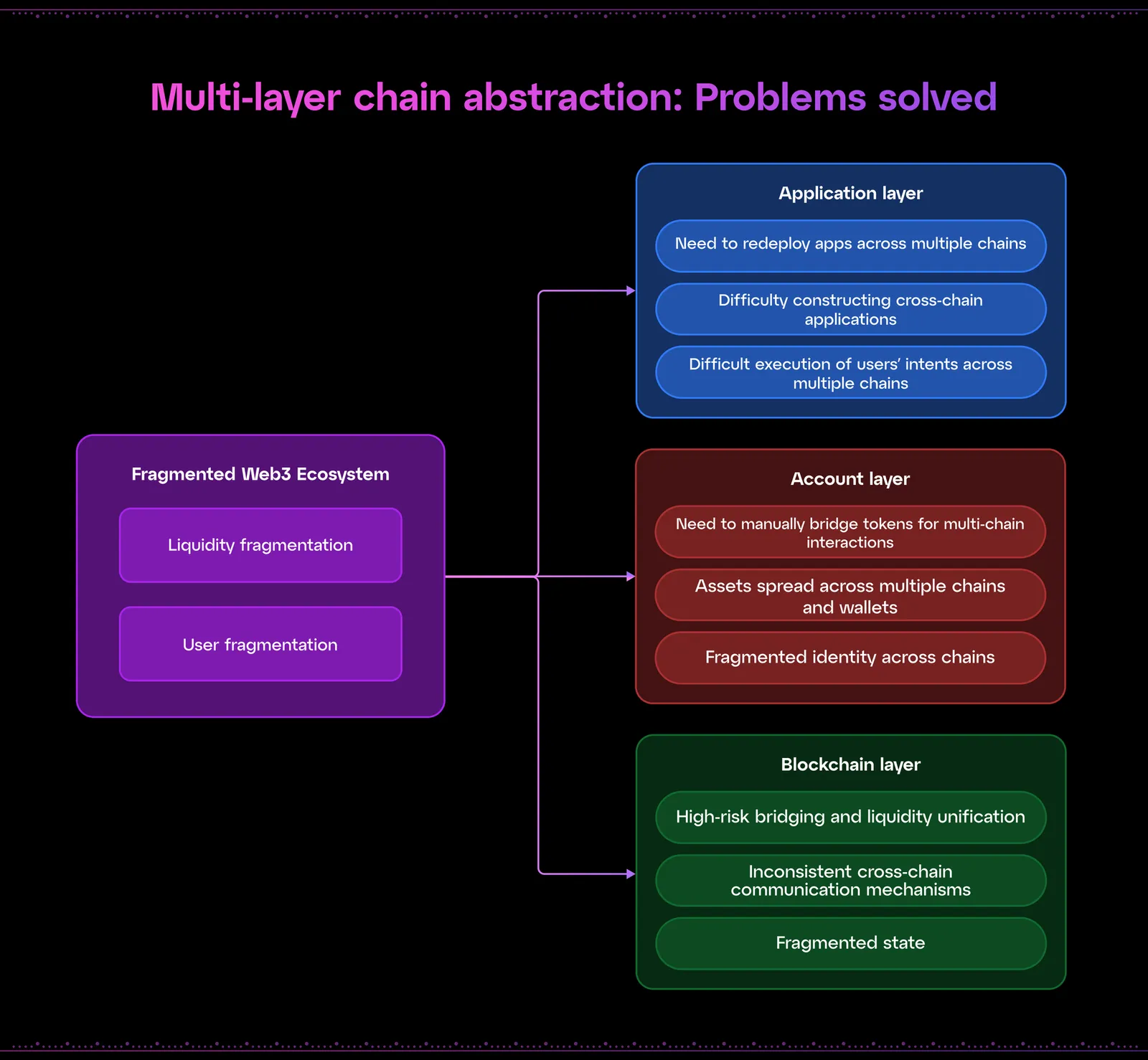
Source: Chain Abstraction vs Account Abstraction
Unlike account abstraction, which is defined by specific technical specifications like EIP-4337, chain abstraction represents a broader methodology. It can be implemented across various layers of the blockchain stack - from applications and accounts to protocols - with the goal of abstracting away the complexity of cross-chain interactions.
Chain abstraction can provide enhanced user experiences on the blockchain, including but not limited to:
Unified Balance Management: Users can manage their assets through a single interface, regardless of which blockchain these assets reside on. This unified approach eliminates the need for users to track balances across different chains or understand the underlying blockchain architecture.
Flexible Payment Systems: Users can pay with any token from any chain. Specialized solvers handle the complexity in the background - accepting various tokens as payment, managing cross-chain bridging, and handling gas fees - while presenting users with a straightforward payment experience.
Seamless Cross-Chain Interactions: While centralized applications could easily offer similar functionality, chain abstraction achieves these benefits while preserving the core principles of blockchain technology: decentralization, individual asset ownership, and security.
Case Study: One Balance
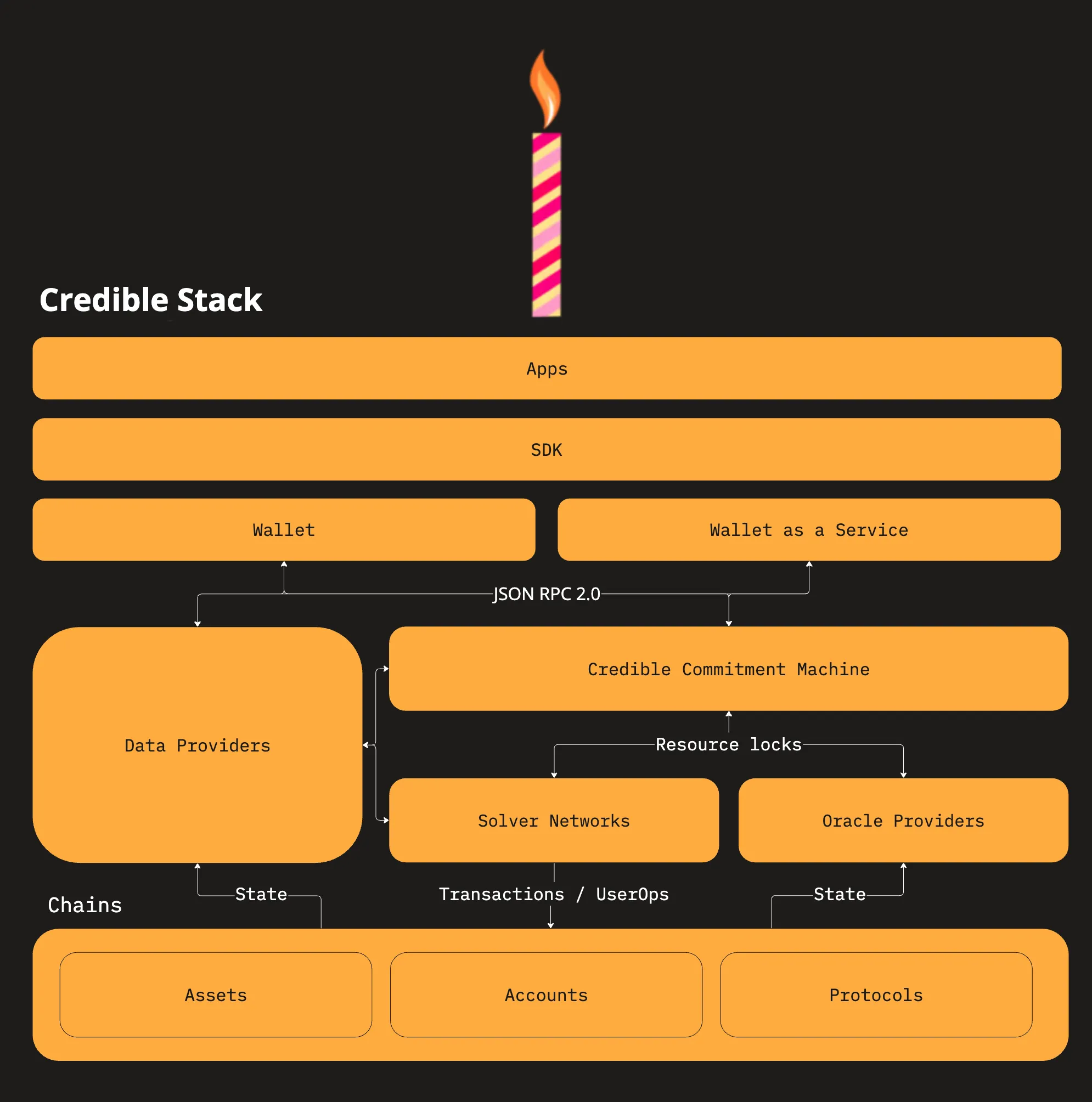
Source: Credible Accounts and Credible Stack
One Balance is a project launched by the Frontier Research team who is know for suggesting their CAKE (Chain Abstraction Key Elements) framework. At the core of their solution is the concept of "Credible Accounts," which combines the advantages of both EOAs and SCAs.
A Credible Account extends traditional blockchain account formats by providing trustworthy guarantees without cross-chain consensus requirements. These accounts operate on user-selected security machines and make credible commitments about message signing. They maintain the security guarantees of SCAs while enabling key features of account abstraction, including gas abstraction, social recovery, permission policies, and modern authentication methods.
Credible Accounts can generate and manage an arbitrary number of sub-accounts across multiple chains, with full control over each chain's state. They are designed to be universally compatible - working with different blockchain networks (Ethereum, Solana, Bitcoin), as well as various smart contracts and asset types including ERC20 tokens, NFTs, DAOs, and DeFi protocols.
One Balance's chain abstraction system is built on two key components:
Resource Lock: A mechanism where users make verifiable commitments to lock their assets until specific conditions are met or time expires. Unlike traditional smart contract deposits or ERC20 approvals, these locks are processed at the account level without requiring on-chain finality. For example, when purchasing a Solana NFT with Ethereum USDC, a user locks their USDC until a specific block height for the NFT purchase. This design protects solvers from risks like double-spending and ensures transaction integrity during cross-chain operations.
Credible Commitment Machines: The secure infrastructure that executes cross-chain transactions. Operating within specialized secure environments, these machines perform two essential functions: they verify the validity of resource locks set by users and ensure accurate execution when lock conditions are met. For example, in a Solana NFT purchase using Ethereum USDC, the commitment machine validates the user's USDC ownership and manages the secure transfer to the seller once the NFT purchase completes. This automated process follows predefined rules to ensure trustworthy execution for all parties. The commitment machine can be implemented through four approaches: TEE, MPC, SCA, or Protocol Virtual Machines.
While One Balance is still in development, they have released integration examples using Privy. Their approach stands out from other chain abstraction solutions by offering a framework that integrates with existing blockchain infrastructure or applications, rather than requiring proprietary chains or systems, thus minimizing adoption barriers.
High-quality mobile applications are surprisingly rare in the crypto ecosystem. There are two main reasons why most crypto applications have primarily evolved around desktop platforms.
The primary driver has been the nature of crypto applications themselves. These platforms typically handle complex financial transactions that demand detailed information, comprehensive analytics, and multiple data points to be displayed simultaneously - all of which are better suited to desktop interfaces. While mobile platforms excel at providing streamlined, user-friendly experiences, they often must sacrifice the depth and breadth of functionality that serious crypto traders and users require. This natural limitation made desktop development the logical priority for most crypto applications.
This desktop-centric evolution has shaped how users interact with crypto applications: they typically maintain a primary wallet that they connect to various applications as needed. However, this model creates significant friction when translated to mobile environments. Users find themselves constantly switching between their wallet app and the main application for basic actions like logging in or signing transactions. This clunky back-and-forth experience stands in stark contrast to the seamless interactions mobile users have come to expect from traditional applications.
The second major hurdle has been the restrictive policies of mobile app stores, with Apple's App Store being particularly challenging. Their stringent guidelines around crypto-related payments have forced many crypto applications to seek creative workarounds. Early attempts to circumvent these restrictions through Progressive Web Apps (PWAs) showed initial promise but ultimately failed to gain traction, largely because users found the installation and usage process unfamiliar and cumbersome. This distribution challenge was further highlighted by Telegram's App Center success story, which managed to onboard an impressive 500 million MAUs across over 1,000 mini-apps, demonstrating the massive potential when crypto applications have access to an effective distribution channel.

However, the landscape is slowly shifting. As the crypto market expands beyond pure financial services into more consumer-friendly territories like meme coins and AI-powered applications, we're seeing a renaissance in mobile-first development. This evolution is evident in the emergence of new players like social platforms (Farcaster, Interface) and memecoin trading platform(Moonshot, Sauce), both of which prioritize sophisticated mobile experiences. Even traditional DEXs like Jupiter and Uniswap are pivoting towards mobile-optimized interfaces to capture a broader audience. This trend is further supported by infrastructure providers, with WaaS platforms like Privy and Reown (formerly WalletConnect) expanding their SDK capabilities to better support mobile-first development. These developments signal a clear industry-wide recognition that mobile optimization is no longer optional but essential for mainstream crypto adoption.
Case Study: Zora

Source: X(@privy_io)
Zora stands as a prime example of how crypto applications can successfully embrace mobile-first design principles. Operating as a social network for digital creations, Zora enables users to seamlessly create, share, and trade various forms of digital content - from images and videos to music and memes.
What sets Zora apart is their comprehensive mobile optimization, from initial account creation through to NFT minting. The onboarding process is remarkably straightforward: users can sign up with just an email address, and those with existing Farcaster or Instagram accounts can connect them to instantly receive personalized feed recommendations and find friends. Perhaps most importantly, Zora leverages native mobile functionality - users can capture photos or videos directly through their phone's camera and mint them as NFTs instantly, creating an experience that feels as natural as posting to traditional social media.
Under the hood, Zora employs sophisticated blockchain technology while maintaining simplicity for users. They've implemented a modern account abstraction stack that combines Privy's embedded wallet technology with Coinbase's smart wallet infrastructure. This technical architecture allows Zora to handle complex operations - like gas fee management and transaction batching - entirely behind the scenes. Users never need to understand or interact with these technical elements, allowing them to focus solely on creating and sharing content.
A particularly innovative aspect of Zora is their in-app currency system called "Spark." Spark is denominated as one millionth of an ETH (equivalent to 1000 Gwei) and can be purchased directly through familiar payment methods like credit or debit cards. The system is designed for ultimate simplicity: with sufficient Spark balance, users can mint NFTs with a simple double-tap gesture. Each mint costs 111 Sparks and includes gasless transactions. Importantly, purchased Sparks never expire and maintain their utility even if Zora's minting fees change in the future.
What makes Zora particularly noteworthy is their successful abstraction of blockchain complexity. All the technical elements that typically create friction in crypto applications - wallet creation, gas fee management, NFT minting processes - are handled invisibly in the background. The result is an experience that feels indistinguishable from using any popular social media app, while still maintaining all the benefits of blockchain technology. This approach has set a new standard for what mobile-first crypto applications can achieve, demonstrating how blockchain technology can be seamlessly integrated into everyday mobile experiences.
he crypto industry has come a long way since the explosive growth of applications during the DeFi and NFT Summer of 2021, which marked a Cambrian explosion of innovation in the space. The subsequent two years have witnessed significant advancements in fundamental infrastructure: modular blockchains have emerged, L1 networks have achieved remarkable performance improvements, and technologies like oracles and bridges have matured substantially. These developments have effectively addressed many of the traditional bottlenecks that once hindered blockchain adoption, particularly the persistent issues of slow transaction speeds and prohibitive fees.
However, while the technical foundation has strengthened considerably, the user experience layer hasn't kept pace. Despite continuous experimentation and development in the application layer, very few crypto platforms can match the seamless, intuitive experience that users have come to expect from Web2 applications. This gap has become increasingly apparent now that our robust infrastructure layer stands ready to support the next generation of applications. The pressing challenge now is to build services that can deliver familiar, Web2-level user experiences while preserving the unique benefits of blockchain technology.
At the heart of this challenge lies the crypto wallet - perhaps the most critical component in determining overall user experience. Wallets serve as the entry point for new users and the gateway for all significant actions within applications, from simple sign-ins to transaction approvals. This positions them as the fundamental layer through which users interact with the entire crypto ecosystem, making their design and functionality crucial to mainstream adoption.
Innovation in wallet technology isn't confined to a single layer but is occurring simultaneously across multiple dimensions - from key management and account structures to UI/UX. Each layer presents unique design parameters that vary based on application characteristics and requirements. The innovation in wallet technology remains ongoing, with new narratives emerging around account abstraction and chain abstraction, alongside the introduction of new technologies like WebAuthn and TEE.
Thus, success of applications may require a delicate understanding of the decision tree within each layer of wallet architecture. By analyzing successful implementation cases and understanding the trade-offs involved, teams can make informed choices that align with their specific use cases while maintaining the balance between functionality and user experience.
The path to widespread crypto adoption ultimately hinges on our ability to make sophisticated blockchain technology accessible to everyday users without compromising on the fundamental principles of decentralization and security. While recent case studies show promising progress in this direction, with innovative solutions emerging across the ecosystem, we're still in the early stages of this transformation. The challenge ahead lies in creating experiences that not only match but exceed those of traditional digital services, all while preserving the unique value propositions that blockchain technology offers. As wallet technology continues to evolve, it will play an increasingly crucial role in shaping how the next generation of users interacts with the crypto applications.
Dive into 'Narratives' that will be important in the next year